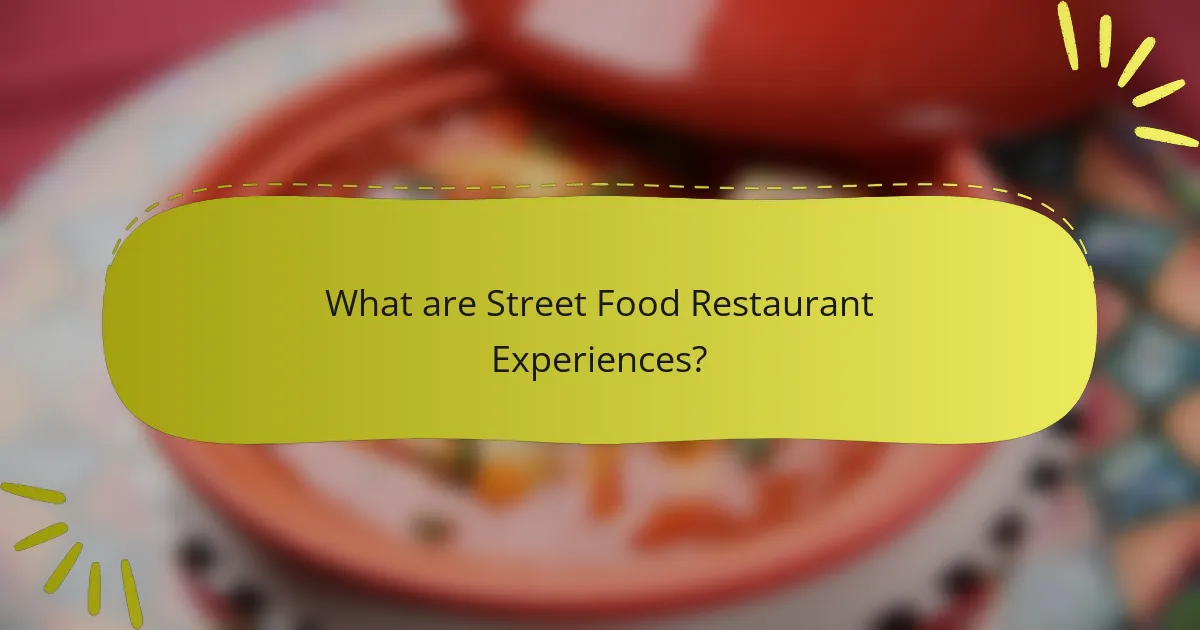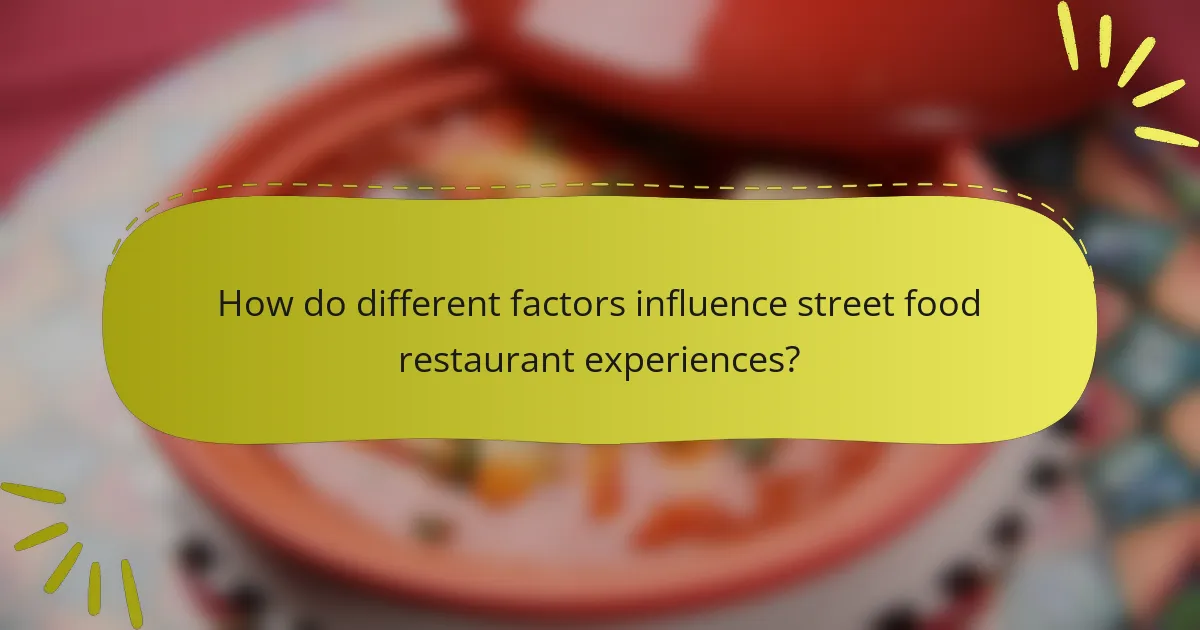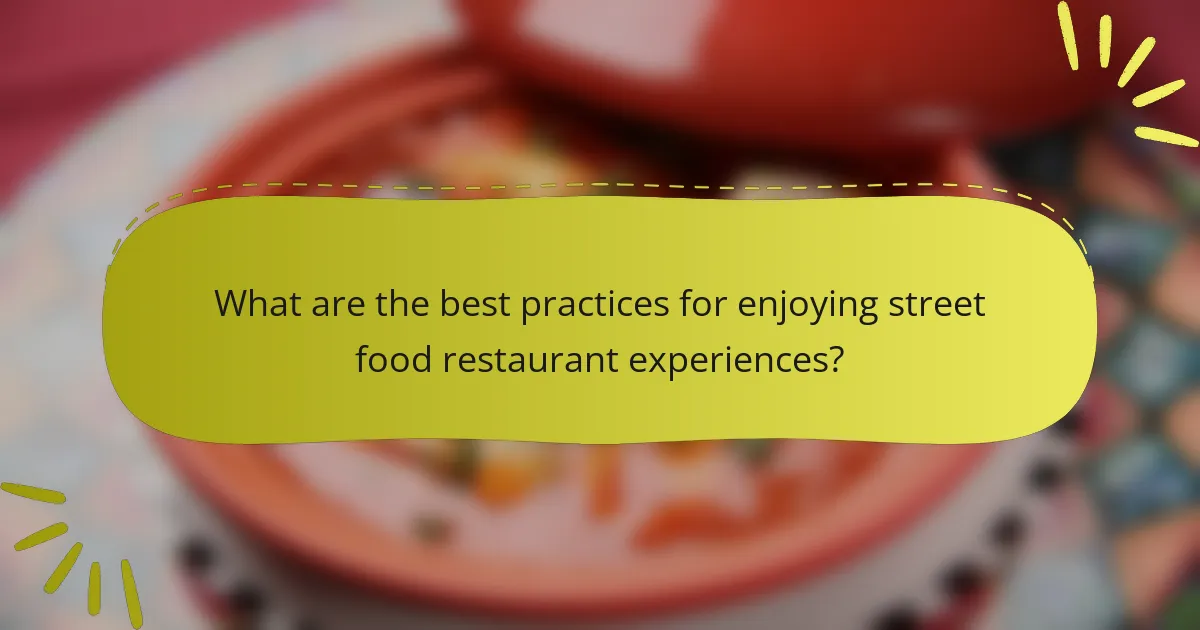Street food restaurant experiences encompass casual dining opportunities that often take place outdoors, featuring food trucks, pop-up stalls, and open-air markets. These experiences highlight a diverse array of international cuisines, emphasizing local flavors and culinary traditions. Key factors influencing these experiences include location, food quality, customer service, ambiance, and pricing. Research indicates that food quality is the most critical factor for 70% of customers, while effective customer service can significantly boost customer loyalty. To maximize enjoyment, diners are encouraged to prioritize hygiene, engage with vendors, and explore a variety of dishes in vibrant settings.

What are Street Food Restaurant Experiences?
Street food restaurant experiences are unique dining opportunities that focus on casual, often outdoor eating environments. These experiences typically involve food trucks, pop-up stalls, or open-air markets. They offer a variety of international cuisines, showcasing local flavors and culinary traditions. Street food is often prepared quickly and served in a vibrant, social atmosphere. Customers can enjoy fresh, affordable meals while engaging with the community. These experiences promote cultural exchange and support local vendors. According to a report by the Street Food Association, street food contributes significantly to urban economies and enhances city life.
How do outdoor dining experiences enhance street food culture?
Outdoor dining experiences enhance street food culture by providing a vibrant and accessible setting for food vendors. These environments attract diverse crowds, increasing foot traffic and visibility for street food offerings. According to a study by the National Restaurant Association, outdoor dining can boost sales by up to 30%. This increase encourages more vendors to enter the market, enriching the variety of food options available. Additionally, outdoor dining fosters social interactions, creating a communal atmosphere that celebrates local cuisine. Events like food festivals further amplify this culture by showcasing multiple vendors in one location, enhancing exposure and appreciation for street food.
What elements contribute to a successful outdoor dining atmosphere?
A successful outdoor dining atmosphere is created by several key elements. Comfortable seating is essential for guest satisfaction. Adequate shade or shelter protects diners from harsh weather. Ambient lighting enhances the dining experience during evening hours. Aesthetic decor adds visual appeal to the environment. Access to clean restrooms contributes to overall comfort. Good airflow or heating ensures a pleasant temperature. Proximity to food preparation areas can enhance the dining experience by providing freshness. Finally, a welcoming atmosphere encourages social interaction among guests. Each of these elements plays a crucial role in creating an enjoyable outdoor dining experience.
How does weather affect outdoor dining experiences?
Weather significantly influences outdoor dining experiences. Rain can deter customers from choosing outdoor seating. High temperatures may lead diners to seek shaded areas or indoor seating. Wind can make outdoor dining uncomfortable, affecting patrons’ enjoyment. Cold weather often reduces the number of diners willing to sit outside. Conversely, pleasant weather typically increases outdoor seating demand. Research indicates that 70% of diners prefer outdoor seating during favorable weather conditions. Seasonal changes also affect menu choices, with lighter dishes favored in warmer months.
What role do food trucks play in street food experiences?
Food trucks are central to street food experiences. They provide accessible and diverse culinary options in urban areas. Food trucks often offer unique, gourmet, and culturally specific dishes that reflect local flavors. They foster community engagement by participating in local events and festivals. Food trucks contribute to the vibrancy of public spaces, attracting crowds and enhancing social interactions. Their mobility allows them to reach different neighborhoods, expanding culinary accessibility. According to the National Food Truck Association, the food truck industry has seen significant growth, indicating their rising popularity in street food culture.
How do food trucks differ from traditional restaurants?
Food trucks differ from traditional restaurants primarily in their mobility and operational structure. Food trucks operate from a mobile vehicle, allowing them to serve food at various locations. Traditional restaurants are fixed establishments that serve customers in a designated space. Food trucks often have limited menus, focusing on specific types of cuisine. In contrast, traditional restaurants typically offer a wider variety of dishes.
The overhead costs for food trucks are generally lower than those for traditional restaurants. This is due to reduced rent and fewer staff requirements. Food trucks also provide a more casual dining experience, often encouraging outdoor eating. Traditional restaurants usually offer a more formal atmosphere with indoor seating.
Moreover, food trucks often participate in events and festivals, enhancing their visibility. Traditional restaurants rely on consistent customer traffic in their location. According to the National Restaurant Association, food trucks have seen significant growth, with a 7.5% increase in sales from 2019 to 2020. This trend highlights the appeal and adaptability of food trucks in the culinary landscape.
What are the benefits of food trucks for consumers and vendors?
Food trucks provide convenience and variety for consumers while offering cost-effective opportunities for vendors. Consumers enjoy easy access to diverse food options in various locations. Food trucks often have lower prices compared to traditional restaurants. This affordability attracts budget-conscious consumers. Vendors benefit from reduced overhead costs compared to brick-and-mortar establishments. They can also reach a broader audience by operating in different areas. Additionally, food trucks can quickly adapt their menus based on consumer preferences and trends. This flexibility allows vendors to stay competitive in the food industry.
What are pop-up events and how do they fit into street food culture?
Pop-up events are temporary food stalls or restaurants that operate for a limited time. They often feature unique culinary offerings and create a sense of urgency for customers. These events fit into street food culture by promoting creativity and experimentation in food. They allow chefs to showcase their skills and introduce new flavors. Pop-ups often take place in urban settings, attracting food enthusiasts. This model fosters community engagement and supports local economies. According to a 2021 report by the National Restaurant Association, pop-up dining experiences have gained popularity, enhancing street food visibility.
How do pop-up events create unique dining experiences?
Pop-up events create unique dining experiences by offering temporary, themed environments that engage diners. These events often feature exclusive menus, making the food offerings distinct and limited. The atmosphere is usually curated to enhance the dining experience, incorporating elements like decor, music, and location. This creates a sense of novelty and excitement for attendees. Additionally, pop-up events often foster community engagement by collaborating with local chefs and artists. According to a study by the National Restaurant Association, 30% of consumers are more likely to try a restaurant that offers unique or limited-time experiences. This indicates that pop-up events effectively attract diners seeking something different.
What challenges do organizers face when planning pop-up events?
Organizers face several challenges when planning pop-up events. One major challenge is securing an appropriate location. Finding a site that is accessible, has necessary permits, and meets safety regulations can be difficult. Limited timeframes for setting up and dismantling the event add pressure. Additionally, organizers must manage logistics such as transportation of equipment and supplies. Budget constraints often restrict marketing and staffing options. Weather unpredictability can also impact attendance and overall success. Lastly, ensuring compliance with health and safety regulations is crucial and can be complex. These factors collectively complicate the planning process for pop-up events.

How do different factors influence street food restaurant experiences?
Different factors significantly influence street food restaurant experiences. Key factors include location, food quality, and customer service. Location affects foot traffic and accessibility. High-quality ingredients enhance flavor and customer satisfaction. Customer service impacts the overall dining experience and repeat business.
Ambiance also plays a role, as an inviting atmosphere can attract more patrons. Pricing affects customer perceptions of value. Cultural factors influence menu offerings and appeal. Seasonal variations may affect ingredient availability and menu changes.
Research indicates that 70% of customers consider food quality the most important factor in their experience. Additionally, a study by the National Restaurant Association highlights that customer service can increase customer loyalty by 60%.
What impact does location have on street food experiences?
Location significantly impacts street food experiences by influencing accessibility, variety, and cultural context. Urban areas often provide a wider range of food options due to higher population density. For example, cities like Bangkok and Mexico City are renowned for their vibrant street food scenes. These locations attract both locals and tourists, enhancing the culinary diversity available.
Additionally, geographical location affects ingredient availability. Coastal areas may offer fresh seafood, while mountainous regions might focus on hearty, local produce. The cultural background of a location also shapes the types of street food offered, reflecting local traditions and flavors.
Research indicates that street food experiences are often tied to social interactions. Locations with high foot traffic facilitate more engagement between vendors and customers. This interaction can enhance the overall experience, making it more memorable. Thus, the location is crucial in defining the street food landscape and the overall enjoyment of the culinary experience.
How can foot traffic affect the success of street food vendors?
Foot traffic significantly affects the success of street food vendors. Higher foot traffic increases visibility and potential customer interactions. Vendors positioned in high-traffic areas generally experience more sales. Studies indicate that street food vendors in busy locations can see a sales increase of up to 40%. Additionally, foot traffic can enhance brand recognition and customer loyalty. Vendors can attract spontaneous purchases from passersby. Seasonal events or festivals can further boost foot traffic, leading to increased sales opportunities. Overall, foot traffic is a critical factor in the operational success of street food vendors.
What are the best locations for food trucks and pop-up events?
The best locations for food trucks and pop-up events include high foot traffic areas, parks, and community events. Urban centers with busy streets attract more customers. Popular tourist spots also provide visibility and access. Local festivals and farmers’ markets create a vibrant atmosphere for food sales. College campuses offer a steady flow of potential customers. Business districts during lunch hours maximize sales opportunities. Events like concerts or sports games draw large crowds. These locations are proven to enhance customer engagement and increase sales for food trucks and pop-up events.
How do cultural influences shape street food offerings?
Cultural influences shape street food offerings by dictating the types of ingredients and cooking methods used. Local traditions and customs inform the flavors and presentation of dishes. For example, in Mexico, street food often features corn and chili, reflecting indigenous agricultural practices. In contrast, Asian street food frequently incorporates rice and noodles, showcasing regional staples. Additionally, cultural festivals can introduce new street food items, blending traditional recipes with modern tastes. Historical migration patterns also influence street food, as diverse communities share their culinary heritage. This results in unique fusion dishes that appeal to a broader audience. Thus, street food offerings are a dynamic reflection of cultural identity and evolution.
What are some popular street food items from different cultures?
Tacos are a popular street food from Mexico. They consist of a folded or rolled tortilla filled with various ingredients. Common fillings include meats, beans, and vegetables. In India, samosas are a favored street snack. These are deep-fried pastries filled with spiced potatoes, peas, or meat. In Thailand, pad thai is often sold as street food. It is a stir-fried rice noodle dish with shrimp, tofu, and peanuts. In Japan, takoyaki are popular. These are savory octopus balls cooked in a special mold. In Italy, arancini are commonly found. They are stuffed rice balls, often filled with cheese or meat and fried. In the Middle East, falafel is a well-known street food. It consists of deep-fried balls made from ground chickpeas or fava beans. Each of these items reflects the culinary traditions of their respective cultures.
How do local ingredients influence street food menus?
Local ingredients significantly influence street food menus by enhancing flavor and authenticity. Street food vendors often use ingredients sourced from nearby farms or markets. This practice supports local agriculture and reduces transportation costs. Fresh, seasonal produce improves the taste and quality of dishes. Regional specialties are highlighted, reflecting local culture and traditions. For instance, a taco stand in Mexico may feature locally sourced corn for tortillas. This connection to local ingredients fosters a sense of community. Additionally, it attracts customers seeking unique, authentic culinary experiences. Overall, local ingredients shape street food offerings, making them distinctive and appealing.

What are the best practices for enjoying street food restaurant experiences?
To enjoy street food restaurant experiences, prioritize hygiene and cleanliness. Choose vendors with high turnover and visible food preparation areas. Observe the cooking process to ensure food is freshly made. Engage with the vendors to learn about their ingredients and cooking methods. Sample a variety of dishes to experience diverse flavors. Visit during peak hours for the freshest options. Pay attention to local recommendations for popular food spots. Street food is often best enjoyed in a lively atmosphere, so embrace the surroundings.
How can consumers choose the best street food options?
Consumers can choose the best street food options by evaluating food safety, vendor reputation, and ingredient quality. Observing cleanliness around the food stall is crucial. A clean area indicates good hygiene practices. Checking the vendor’s popularity is also important. High foot traffic often signifies quality food. Engaging with other customers can provide insights into taste and satisfaction. Freshness of ingredients can be assessed by looking for daily preparation signs. Additionally, consumers should consider the variety of menu options available. Diverse offerings often reflect a vendor’s expertise. Lastly, looking for food that is cooked to order can enhance freshness and flavor.
What factors should be considered when selecting a food truck or pop-up event?
Key factors to consider when selecting a food truck or pop-up event include location, target audience, and menu offerings. Location affects foot traffic and accessibility. A high-traffic area increases visibility and sales potential. Understanding the target audience helps tailor offerings to their preferences. Menu offerings must be unique and appealing to stand out. Additionally, operational logistics such as permits, equipment, and staffing are critical. Compliance with local health regulations is also essential for safety. Lastly, marketing strategies can enhance visibility and attract customers.
How can diners ensure food safety while enjoying street food?
Diners can ensure food safety while enjoying street food by following several key practices. First, they should choose vendors with high cleanliness standards. Observing the preparation area can reveal hygiene practices. Second, diners should opt for freshly cooked food. Hot food is less likely to harbor harmful bacteria. Third, they must avoid uncooked or raw items, especially seafood and meats. Consuming these can increase the risk of foodborne illnesses. Fourth, diners should check for food safety certifications or permits displayed by vendors. This indicates compliance with local health regulations. Fifth, using hand sanitizer before eating is essential for reducing germs. Lastly, diners should report any food safety concerns to local health authorities. These steps significantly lower the risk of food-related health issues while enjoying street food.
What tips can enhance the street food dining experience?
To enhance the street food dining experience, choose popular vendors known for quality. Popularity often indicates better food safety and taste. Arrive during peak hours for fresher options. Freshly prepared food is typically more flavorful. Engage with vendors to learn about the dishes. Understanding ingredients can enrich your experience. Opt for dishes that are freshly cooked in front of you. This ensures hot and safe food. Explore diverse offerings to broaden your palate. Trying various cuisines can enhance enjoyment. Bring cash for quicker transactions. Many street vendors prefer cash over cards. Lastly, enjoy the atmosphere and interact with fellow diners. A vibrant environment adds to the overall experience.
How can sharing food enhance the enjoyment of street food?
Sharing food enhances the enjoyment of street food by fostering social interaction. When people share dishes, they create a communal atmosphere. This atmosphere encourages conversation and bonding among diners. Sharing allows individuals to sample a variety of flavors. This diversity enriches the overall culinary experience. Studies show that shared meals can increase happiness and satisfaction. According to research from the University of Oxford, communal dining boosts positive emotions. Sharing food also makes the experience more memorable. Overall, sharing food transforms street food into a social event.
What are some recommended etiquette practices for street food dining?
Recommended etiquette practices for street food dining include being mindful of queues. Respecting the order of those waiting ensures a smooth experience for everyone. It is also important to have exact change ready. This practice speeds up the transaction and minimizes delays. Additionally, consuming food in designated areas is crucial. Many vendors appreciate when diners do not block walkways. Using napkins and disposing of trash properly shows respect for the vendor and the environment. Finally, thanking the vendor after your purchase can foster goodwill and appreciation. These practices contribute to a positive street food culture.
Street food restaurant experiences encompass casual dining opportunities that highlight outdoor settings, food trucks, and pop-up events. This article explores the unique characteristics of street food, including its cultural significance, the role of outdoor dining in enhancing the street food culture, and the impact of location and foot traffic on vendor success. It also examines the benefits of food trucks and pop-up events for consumers and vendors, while offering best practices for enjoying street food safely and responsibly. Key factors influencing street food experiences, such as weather, hygiene, and community engagement, are also discussed to provide a comprehensive understanding of this vibrant culinary landscape.